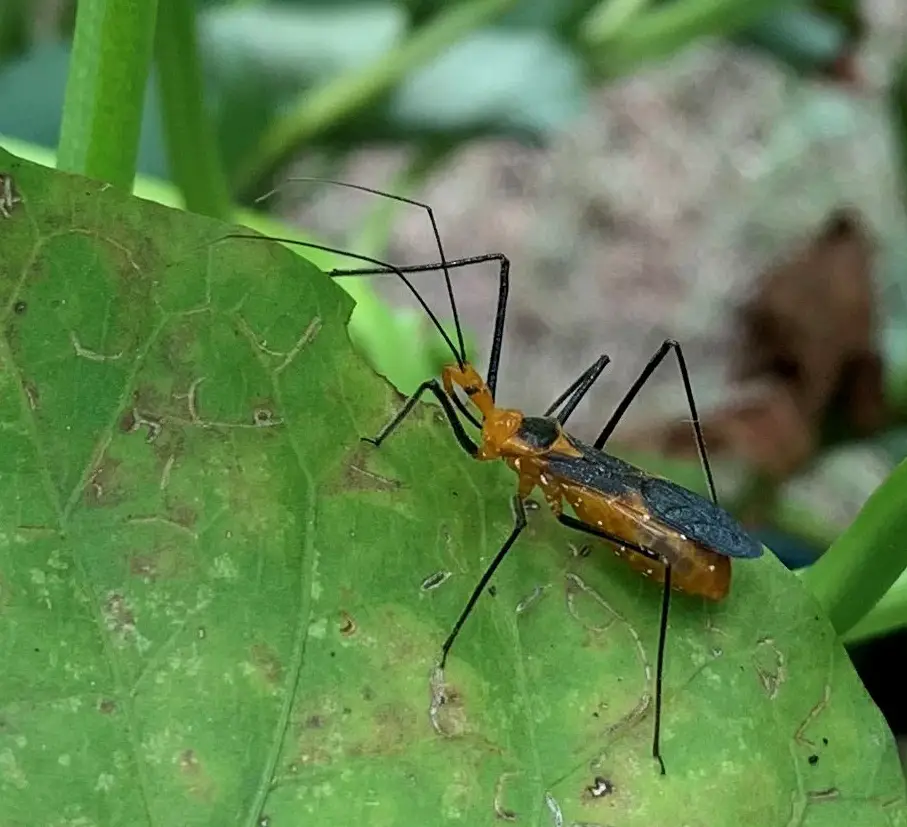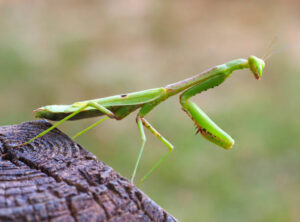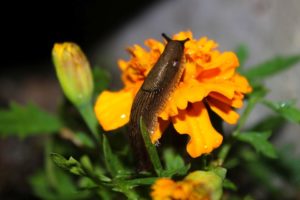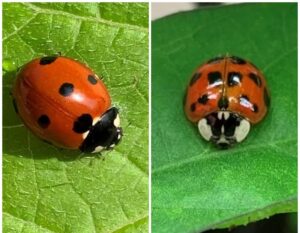Assassin bugs are not your average garden variety insect. Instead of eating plants, they feed on a wide assortment of garden pests and their larvae, including aphids, armyworms, caterpillars, mosquitoes, beetles, and leafhoppers. These fearless feeders will even attack bugs that are bigger than they are. The downside to their carnivorous ways is that they will also eat beneficial insects like ladybugs and bees.
Assassin bugs are members of the Reduviidae insect family. They are also sometimes referred to as kissing bugs, although, technically, kissing bugs are a type of assassin bug. There are about 160 species of these insect-hunters in North America and about 3,000 worldwide. Their habitat is diverse, and they can be found in and among woodpiles, forests, flowerbeds, shrubs, vegetable gardens, ground cover, and orchards.
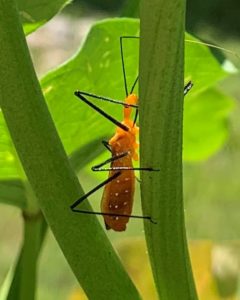
Because there are so many species, their physical description varies to some extent. But in general, they have somewhat oval-shaped bodies that measure between 1/2 to 1 1/4 inches (1.27 cm to 3.2 cm) long. Most are black or brown, but some are also brightly colored with red, orange, yellow, and green. They have long legs that they can use to hold down their prey. Their wings fold flat against their backs, creating an x-shaped pattern on some species.
These stealth hunters use their beady eyes, which protrude from their small, cone-shaped heads, to locate their prey. Their heads, which are considerably more narrow than their bodies, also have long, sometimes jointed, antennae.
Perhaps the most fascinating anatomical aspect of the assassin bug is its proboscis, a segmented tube connected to its rostrum (beak-like mouth) that folds into a groove located between its front legs. Instead of chewing, like many garden insects, the assassin bug uses the tip of its sharp rostrum to pierce its prey and inject a toxin that kills and then liquefies its victim’s innards. It then sucks up the slurry through its proboscis-rostrum.
Some species, like the pale green assassin bug, coat their forelegs with a sticky substance that attracts prey. Others use the carcass of a dead bug as a lure to draw unsuspecting insects into ambush range. Regardless of the method, assassin bugs are fierce predators!
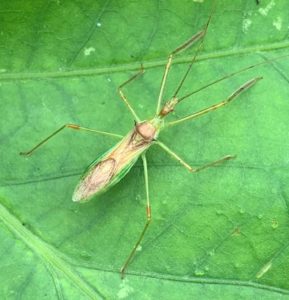
Beneficial Bugs with a Bad Bite!
Insects are not the only ones who may suffer from an assassin bug’s bite. Humans and animals may also be on the receiving end of their sharp proboscis, which can be very painful! Be aware that adults and older nymphs of some species of assassin bugs, like the kissing bug, can transmit Chagas. This inflammatory infectious disease, if not treated, can lead to serious health conditions, including heart failure and organ damage. Sadly, it can also be fatal. Therefore, be sure to keep a safe distance so as not to provoke an assassin bug, or it may attack in self-defense.
Life Cycle
There is a marked difference between species as to when the adult female lays her eggs and how long it takes for the larvae to hatch and fully develop. The milkweed assassin bug, for example, lays her eggs in late summer. The bottle-shaped eggs are laid in a cluster on a host plant, often on the underside of leaves or on the plant’s stem.
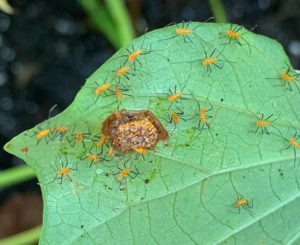
The nymphs will molt four times before reaching adulthood. In the beginning, their legs are black, and their thorax and swayed abdomens are orange and black. As the nymphs mature, their bodies elongate, change color, and develop wings, signaling their arrival at adulthood. The whole process from egg to adult can take four to eight weeks, depending on the temperature.
Other species lay their eggs in the summer, and the nymphs will be semi-dormant over the winter and emerge to molt in the spring. The process can take a full year. Still, other species complete the process in a few months, and they overwinter in the adult stage.
Assassin Bug Look-Alikes
Assassin bugs are often confused with squash bugs, leaf-footed bugs, and shield bugs (a.k.a. stink bugs), none of which are in the same family. The nymphs of the assassin bugs and leaf-footed bugs, in particular, look very similar. One way to distinguish between the two is that the leaf-footed nymphs and adults have flared hind legs, although it may be difficult to discern in the nymphs. Another way to distinguish between assassin bug nymphs and the leaf-footed variety is that after they have hatched, assassin bugs are usually loners, while the leaf-footed nymphs tend to congregate.
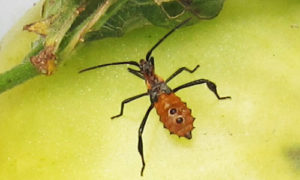
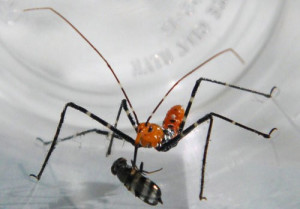
Common Species
Here is a list of some of the more common or well-known assassin bugs:
Milkweed Assassin bugs are red and black. They secrete a sticky substance on their legs which they use to catch their prey.
Kissing Bugs are not the affectionate bugs that their name implies. Instead, these assassins like to bite the eyes and lips of humans while they sleep, and thus appear to be kissing their prey. They are brown to black in color with short red to cream-colored stripes on the edges of their abdomens. This species can carry Chagas, a serious infectious disease.
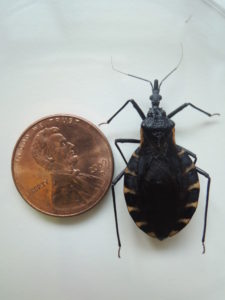
Ambush Bugs are smaller and stouter than their assassin cousins. Instead of stalking their prey, they lay in wait. They are often found on flowers.
Leafhopper Assassin Bugs are reddish-brown and green. Named after one of their preferred prey, they also feed on other insects.
Wheel Bugs, the largest species in North America, are gray in color and are unique in that they have a crest the shape of a half wheel with spokes on the back of their necks. Some also describe the crest as resembling a circular saw blade.
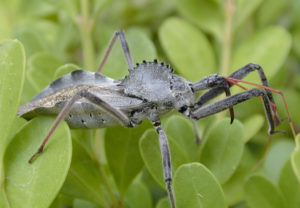
This article contains affiliate links. If you make a purchase using one of these links, I will receive a very small commission at no additional cost to you, and it will help me maintain this website. Rest assured, I only recommend products I actually like!
How to Attract Assassin Bugs to Your Garden
Assassin bugs are considered by many to be beneficial insects and are especially prized by organic gardeners who often prefer to use natural pest control methods. There are a few things you can do to make your garden more inviting to these predatory bugs:
- Refrain from using pesticides and insecticides that can harm assassin bugs and other beneficial insects.
- Add mulch to provide a place for assassin bugs to hide.
- Place a “watering hole” made of small rocks or marbles in a shallow tray or dish filled with water. This is also helpful for bees and other pollinators.
- Add solar lights to your garden. They will attract assassin bugs, as well as their prey.
- Assassin bugs are said to be fond of marigolds, daisies, Queen Anne’s lace, and tansy. Plant these to attract assassin bugs to your garden.
- Plant herbs like dill, anise, and fennel, which are said to attract assassin bugs.

Assassin bugs are fascinating insects that are a welcomed sight for many gardeners. While they may also prey on other beneficial insects, by and large, their presence in the garden can outweigh any drawbacks. Like the green lynx spider, show them respect, and they will help you with pest management.
Thank you for reading this article! If you found it helpful, please consider sharing it with others via email and on social media!
